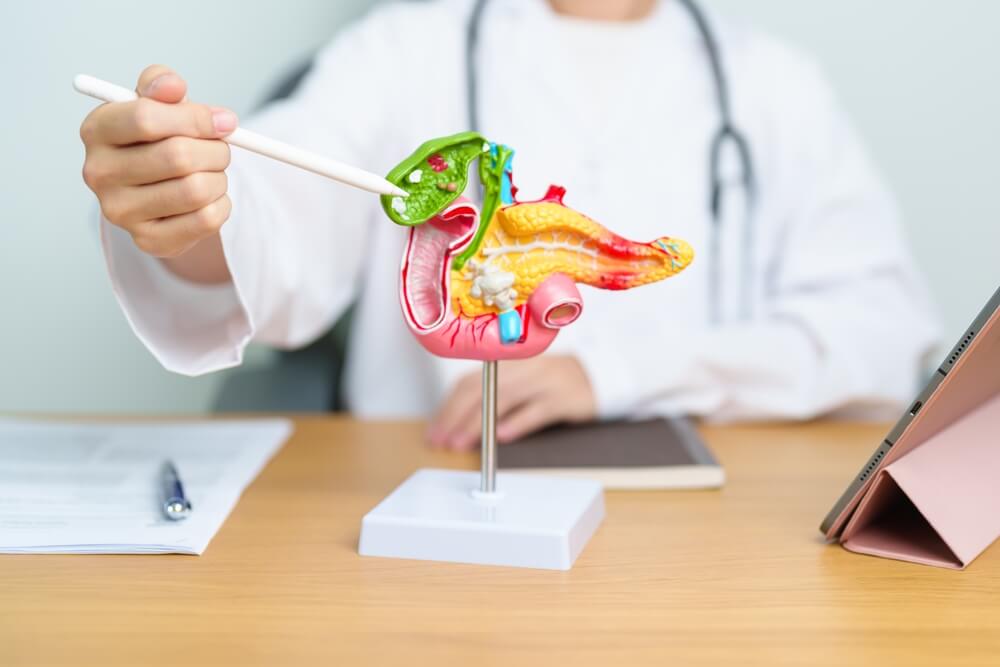Gallbladder polyps may be defined as abnormal tissue growths that protrude from the gallbladder’s mucus lining. There may be several types of gallbladder polyps; based on the materials they consist of. For the most part, these polyps are entirely harmless, but in other cases, they may signal a more serious medical condition. In rare cases, they may lead to other complications, like inflammation, and in even rarer cases, they may become malignant.
If you are looking for options for gallbladder surgery in Wellington, FL, consider learning more about us at Advanced Surgical Physicians. We strive to provide compassionate, high-quality care using the most advanced medical technology.
Still, before you reach out to us, consider reading this article, where we discuss the causes of gallbladder polyps, talk about symptoms, and explore treatment methods.
About The Gallbladder and Gallbladder Polyps
The gallbladder is a hollow, small organ under the liver resembling a fig. As an essential part of the digestive system, the organ receives bile from the liver, extracting water from it and storing it. When lipids (fats) enter the digestive tract, the organ’s triggered to release said concentrated bile into the small intestine to break down lipids.
Gallbladder polyps are relatively rare, with only four to seven percent of adults developing them. Out of all cases, five percent may actually turn into cancer. Still, the most prevalent types of these polyps are cholesterol polyps in the gallbladder or pseudopolyps. These aren’t growths per se but cholesterol deposits that are attached to the organ’s wall. About 60 or 90 percent of gallbladder polyps are cholesterol polyps, and another five to ten percent are inflammatory polyps, the scar tissue resulting from chronic inflammation.

Types of Gallbladder Polyps
Pesudipolys: These are the so-called cholesterol polyps in the gallbladder. They are the result of cholesterolosis, a benign condition in which an excess amount of cholesterol fat accumulates in the gallbladder and sticks to its wall.
Adenomas: These are benign tumors made up of cells that look like the biliary tract’s lining, which is the channel connecting the gallbladder to other organs. In extremely rare cases (0.5 percent), they may turn malignant.
Inflammatory polyps: These are scar tissue formations resulting from the gallbladder wall’s chronic inflammation.
Adenomyomatosis: This refers to the gallbladder lining’s abnormal overgrowth, resulting in cyst development on the gallbladder wall. It’s a harmless condition, and at the moment, scientists are unsure of its causes.
Malignant polyps: Usually adenocarcinoma, which is the most prevalent malignancy that affects internal organs.
Causes and Symptoms of Gallbladder Polyps
For the most part, actual tumors result from abnormal cell growth. On that note, inflammatory and cholesterol polyps don’t qualify as true growths, as they are the results of other conditions. These two are the most common types of polyps. For the rest (or true tumors), scientists are unsure of the exact causes of gallbladder polyps.
Regarding the symptoms of gallbladder polyps, they don’t actually produce any signs or pain. In extremely rare cases, they may lead to inflammation and pain if they happen to block the bile ducts. Still, pain and inflammation are also more closely associated with other conditions, most specifically, gallstones.
Some polyps may also form in the cystic duct and may block the bile flow into the gallbladder, leading to inflammation. The pieces that may break off can travel into the duct, blocking the bile flow out of the organ, leading to the inflammation of the bile duct itself or the pancreas.
These inflammatory symptoms may include:
- Jaundice
- Fever
- Vomiting and nausea
- Abdominal pain
In rare cases, these symptoms may also indicate a gallbladder malignancy.
When assessing risk factors, people who have the following are also more susceptible to developing gallbladder polyps:
- Cholangitis
- Cholecystitis
- Gallstones
- Hepatitis B.
- FAP or Familial Adenomatous Polyposis.
- High cholesterol
- Petuz-Jeghers Syndrome
- Being over the age of 50
Diagnosing Gallbladder Polyps
Mostly these polyps are usually discovered by chance during radiology exams. These tests are effective in identifying gallbladder polyps but might not be able to establish the particular type. As such, the doctor may recommend follow-up testing with the help of more advanced imaging techniques, such as endoscopic ultrasounds or CT scans.
Unfortunately, healthcare experts simply can’t tell precisely whether a polyp is cancerous without removing them. To make things more complicated, removing the polyps is impossible without removing the entire gallbladder. While life without this organ is possible, providers will still do everything they can to avoid the removal of the gallbladder. As such, they will try to calculate the chances of the polyps being cancerous based on the patient’s risk factors and symptoms.
On that note, cancerous polyps may grow faster than benign ones. The latter also tend to develop in numbers, while cancerous polyps are usually single.
Lastly, these polyps can’t resolve on their own and will probably keep on growing in size and number until they are removed with the help of surgery.
The Treatment of Gallbladder Polyps
Generally, healthcare providers will recommend the following treatment approaches:
Observation
Most of these polyps will not lead to any problems and won’t require treatment. Still, doctors might want to regularly examine them to ensure they aren’t growing too fast or too big to produce any new symptoms. The observation is performed with the help of periodic ultrasound tests, and if they see any troubling changes, they might recommend the removal of the gallbladder.
Surgery
While a surgical intervention might seem severe, it’s the only treatment for gallbladder polyps. If the polyps also cause inflammation and are accompanied by gallstones, doctors might recommend the removal of the organ to avoid further complications.
On that note, there two most prevalent types of gallbladder removal surgery are:
- Laparoscopic cholecystectomy, which is a minimally invasive procedure, allows surgeons to remove the organ via a few tiny incisions. Surgeons will only insert a small lighted device with a camera on it (a laparoscope) through a small incision to locate the gallbladder. They then make another small incision to remove the gallbladder with other, similarly thin medical instruments. This method leads to fewer complications and promotes faster healing and recovery.
- Open cholecystectomy will often be recommended when experts suspect cancer. This is because providers may also need to remove additional tissue and lymph nodes outside of the gallbladder that may also be affected by abnormal cell growth. During this open surgery, surgeons may make a larger incision under the ribcage and open the abdomen. This method will require a longer recovery period.
Like any other surgery, gallbladder removal will involve at least some risks, such as bleeding, anesthesia-related complications, and nearby organ injury. Still, there are no long-term side effects of gallbladder removal, and the risks are compared to the risks associated with potential cancer.
Most patients will recover relatively fast after surgery, and their digestive systems will function fine without the gallbladder. The absence of the organ might mean that some patients will need to limit their fat intake following surgery, but they can return to their normal diet within a few weeks.

Learn More
All in all, for the most part, gallbladder polyps shouldn’t be a major concern. Most of them may produce no symptoms at all and will only be discovered during an imaging exam for another condition. In rare cases, the polyps may turn out to be cancerous, which will warrant organ removal. Even then, most removed polyps turn out to be benign in the end. Still, it’s better to remain on the safe side.
If you’d like to hear more about these polyps and available treatment options, feel free to reach out to us today.


